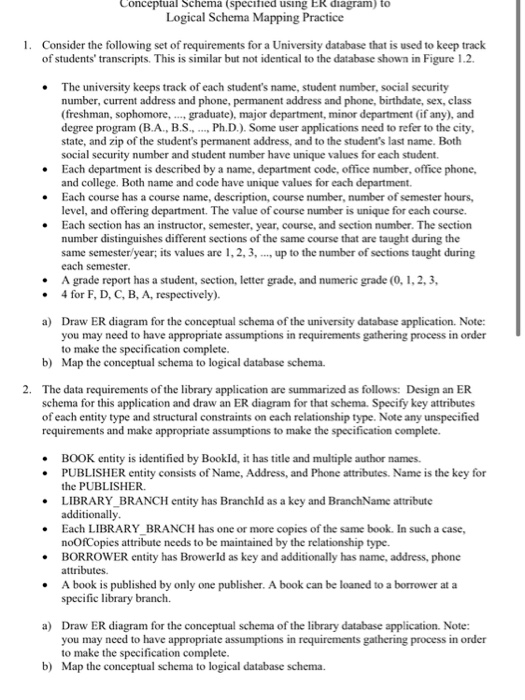MySQL

Conceptual schema (specified using ER diagram) to Logical Schema Mapping Practice 1. Consider the following set of requirements for a University database that is used to keep track of students' transcripts. This is similar but not identical to the database shown in Figure 1.2. The university keeps track of each student's name, student number, social security number, current address and phone, permanent address and phone, birthdate, sex, class (freshman, sophomore, graduate), major department, minor department (if any), and degree program (B.A., B.S., ., Ph.D.). Some user applications need to refer to the city. state, and zip of the student's permanent address, and to the student's last name. Both social security number and student number have unique values for each student Each department is described by a name, department code, office number, office phone, and college. Both name and code have unique values for each department Each course has a course name, description, course number, number of semester hours, level, and offering department. The value of course number is unique for each course. Each section has an instructor, semester, year, course, and section number. The section number distinguishes different sections of the same course that are taught during the same semester/year, its values are 1, 2, 3, ..., up to the number of sections taught during cch Sister. A grade report has a student, section, letter grade, and numeric grade (0, 1, 2, 3, 4 for F, D, C, B, A, respectively). a) Draw ER diagram for the conceptual schema of the university database application. Note: you may need to have appropriate assumptions in requirements gathering process in order to make the specification complete. b) Map the conceptual schema to logical database schema. 2. The data requirements of the library application are summarized as follows: Design an ER schema for this application and draw an ER diagram for that schema. Specify key attributes of each entity type and structural constraints on each relationship type. Note any unspecified requirements and make appropriate assumptions to make the specification complete. BOOK entity is identified by Bookld, it has title and multiple author names. PUBLISHER entity consists of Name, Address, and Phone attributes. Name is the key for the PUBLISHER LIBRARY BRANCH entity has Branchld as a key and BranchName attribute additionally. Each LIBRARY BRANCH has one or more copies of the same book. In such a case, noOfCopies attribute needs to be maintained by the relationship type. BORROWER entity has Browerld as key and additionally has name, address, phone attributes A book is published by only one publisher. A book can be loaned to a borrower at a specific library branch. a) Draw ER diagram for the conceptual schema of the library database application. Note: you may need to have appropriate assumptions in requirements gathering process in order to make the specification complete. b) Map the conceptual schema to logical database schema. Conceptual schema (specified using ER diagram) to Logical Schema Mapping Practice 1. Consider the following set of requirements for a University database that is used to keep track of students' transcripts. This is similar but not identical to the database shown in Figure 1.2. The university keeps track of each student's name, student number, social security number, current address and phone, permanent address and phone, birthdate, sex, class (freshman, sophomore, graduate), major department, minor department (if any), and degree program (B.A., B.S., ., Ph.D.). Some user applications need to refer to the city. state, and zip of the student's permanent address, and to the student's last name. Both social security number and student number have unique values for each student Each department is described by a name, department code, office number, office phone, and college. Both name and code have unique values for each department Each course has a course name, description, course number, number of semester hours, level, and offering department. The value of course number is unique for each course. Each section has an instructor, semester, year, course, and section number. The section number distinguishes different sections of the same course that are taught during the same semester/year, its values are 1, 2, 3, ..., up to the number of sections taught during cch Sister. A grade report has a student, section, letter grade, and numeric grade (0, 1, 2, 3, 4 for F, D, C, B, A, respectively). a) Draw ER diagram for the conceptual schema of the university database application. Note: you may need to have appropriate assumptions in requirements gathering process in order to make the specification complete. b) Map the conceptual schema to logical database schema. 2. The data requirements of the library application are summarized as follows: Design an ER schema for this application and draw an ER diagram for that schema. Specify key attributes of each entity type and structural constraints on each relationship type. Note any unspecified requirements and make appropriate assumptions to make the specification complete. BOOK entity is identified by Bookld, it has title and multiple author names. PUBLISHER entity consists of Name, Address, and Phone attributes. Name is the key for the PUBLISHER LIBRARY BRANCH entity has Branchld as a key and BranchName attribute additionally. Each LIBRARY BRANCH has one or more copies of the same book. In such a case, noOfCopies attribute needs to be maintained by the relationship type. BORROWER entity has Browerld as key and additionally has name, address, phone attributes A book is published by only one publisher. A book can be loaned to a borrower at a specific library branch. a) Draw ER diagram for the conceptual schema of the library database application. Note: you may need to have appropriate assumptions in requirements gathering process in order to make the specification complete. b) Map the conceptual schema to logical database schema








